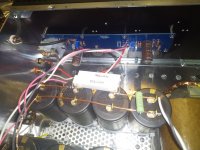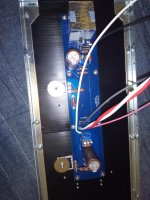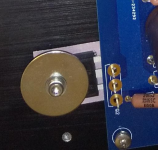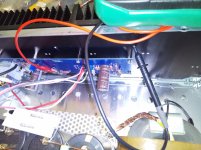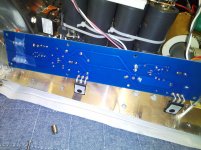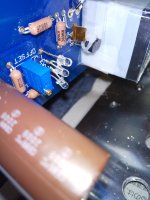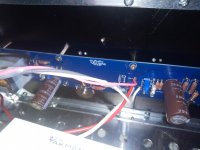Meanie, the amp looks great! Thanks for sharing!
Thanks Mikerodrig27,
This chassis fits perfectly for those using Conrad Heatsinks (350x151), it is available in Aliexpress for a very low price.
KYYSLB DIY Home Audio Box Case 285*150*370mm WA109 Aluminum Amplifier Chassis Class A Amplifier Pure Post amplifier Case|Amplifier| - AliExpress
Meanie,
That's a nice build you got there. And smart work using the big Conrad heat-sinks with that chassis.
That's a nice build you got there. And smart work using the big Conrad heat-sinks with that chassis.
Thanks Mikerodrig27,
This chassis fits perfectly for those using Conrad Heatsinks (350x151), it is available in Aliexpress for a very low price.
KYYSLB DIY Home Audio Box Case 285*150*370mm WA109 Aluminum Amplifier Chassis Class A Amplifier Pure Post amplifier Case|Amplifier| - AliExpress
That chassis is a good deal. I noticed that Conrad Heatsinks is in Australia. Their pricing seems reasonable though.
Hello.
I have wired everything then tried with bulb tester.
PSU is no problem with 25V. The light off after few seconds.
But after connected PCB, The light was bright and didn't off.
I have checked Mosfet.Every middle pin (drain?)have shorted with
chaiss. I take out PCB from heat sink but one of mosfet middle pin
have still short with ground.
Can someone guess what happening?
I have wired everything then tried with bulb tester.
PSU is no problem with 25V. The light off after few seconds.
But after connected PCB, The light was bright and didn't off.
I have checked Mosfet.Every middle pin (drain?)have shorted with
chaiss. I take out PCB from heat sink but one of mosfet middle pin
have still short with ground.
Can someone guess what happening?
Attachments
From your second photo, it seems that after you have tapped the exposed hole, there's a raised lip and maybe if that's common to the other tapped holes, this would be enough to punch through the insulation and short out the device -
I suggest you disassemble all the fets to check and maybe champher (remove that burr) with each tapped hole to make sure no edges remain - just saying, mind you - an easy oversight
I suggest you disassemble all the fets to check and maybe champher (remove that burr) with each tapped hole to make sure no edges remain - just saying, mind you - an easy oversight
@jameshillj
Thank you. Tapping holes were not clean with alminium chips.
Do I have to change mosfets or another parts?
There was no smoke or smell came out.
Thank you. Tapping holes were not clean with alminium chips.
Do I have to change mosfets or another parts?
There was no smoke or smell came out.
I don't really have an answer for the health of the devices but suggest you just measure them in circuit to see if any are 'shorted' etc. You just might have escaped the 'smoke test' at the reduced 'bulb test' voltage level - fingers crossed.
Do I see that 'triple led' upgrade there?
Another suggestion, if you're of mind, is to bypass the SuperThru caps on your power supply (neat job with the 'tie-wraps) with something like those green BP version about 470uF - or perhaps just attach some of those Silmics if you have some spare to see if it
I found that the "SuperThrough" [Nichicon KG(M)] were good next to the rectifier bridges and the "Elna for Audio" caps better after the resistor of the C-R-C supply - it seemed to improve the amps clarity and more 'punch' in the bass but maybe just in my setup too - those "SuperThrough caps are a bit of a puzzle, IMO, and I've got a box of the 6,800/100v ones!
Do I see that 'triple led' upgrade there?
Another suggestion, if you're of mind, is to bypass the SuperThru caps on your power supply (neat job with the 'tie-wraps) with something like those green BP version about 470uF - or perhaps just attach some of those Silmics if you have some spare to see if it
I found that the "SuperThrough" [Nichicon KG(M)] were good next to the rectifier bridges and the "Elna for Audio" caps better after the resistor of the C-R-C supply - it seemed to improve the amps clarity and more 'punch' in the bass but maybe just in my setup too - those "SuperThrough caps are a bit of a puzzle, IMO, and I've got a box of the 6,800/100v ones!
Hello.
Can someone guess what happening?
Look att mosfet. Looks something is missing.
Attachments
Sorry for old photo.
I have soldered before check.
I am not sure how to check the mosfets yet.
So I have tested with degital tester/alarm
to check it's short.
I have soldered before check.
I am not sure how to check the mosfets yet.
So I have tested with degital tester/alarm
to check it's short.
Take a photo of where you are measuring the short.
Are the trimpots in the centre position?
Did you trim all lead wires from underneath the pcb?
Are the trimpots in the centre position?
Did you trim all lead wires from underneath the pcb?
Also as James said earlier remove pcb and check nothing has pierced through the pads, and debur tapped holes.
It is normal to expect that the bulb tester to stay lit once you load the power supply with the Amp.
So unless you have actually measured a short somewhere you may not have one.
So unless you have actually measured a short somewhere you may not have one.
Yeah, I've been 'caught-out" like that before too - failed to make sure nothing in the threaded hole didn't later get pushed out and cut thru the insulating film - I now try to avoid it with transistor clips, bars, etc and as I tend to 'play' with the circuit board components more than once - an inveterate fiddler!
It does produce a uniform and consistent pressure between the transistor and heatsink but unsure if that's absolutely necessary for diy like this.
It does produce a uniform and consistent pressure between the transistor and heatsink but unsure if that's absolutely necessary for diy like this.
Thanks a lot for informations.
I must misunderstood for bulb tester.
The bulb keeps bright.
I have checked how trimpot works but possibly upside down.
I have set clockwise full. I will check it again.
I must misunderstood for bulb tester.
The bulb keeps bright.
I have checked how trimpot works but possibly upside down.
I have set clockwise full. I will check it again.
Attachments
- Home
- Amplifiers
- Pass Labs
- F6 Illustrated Build Guide
